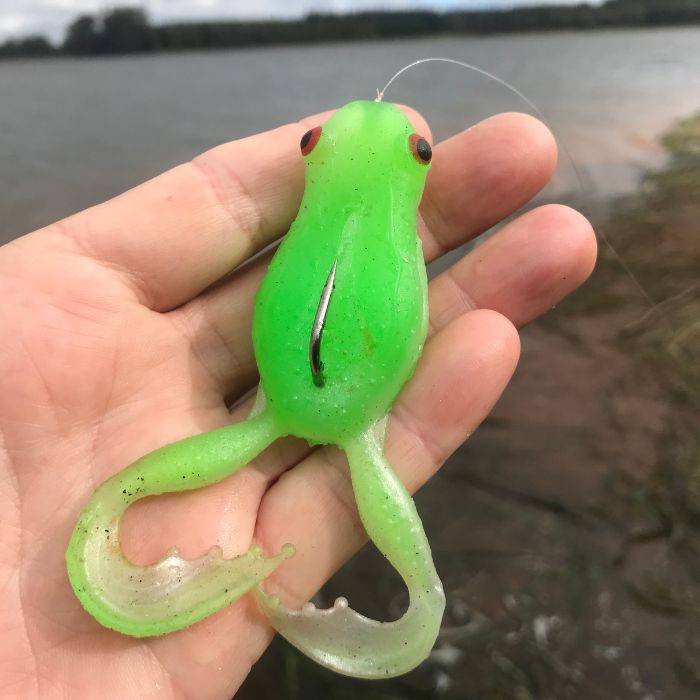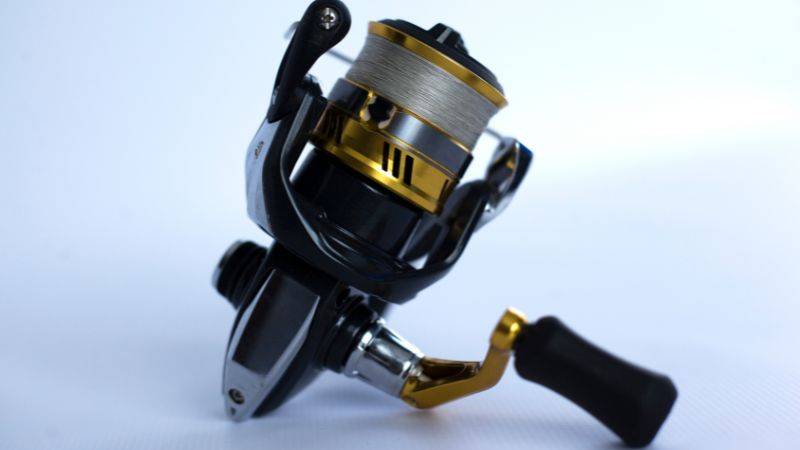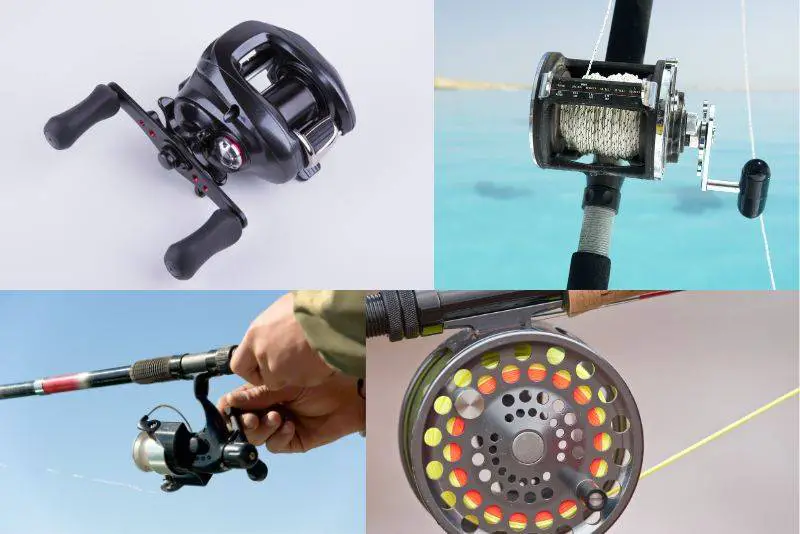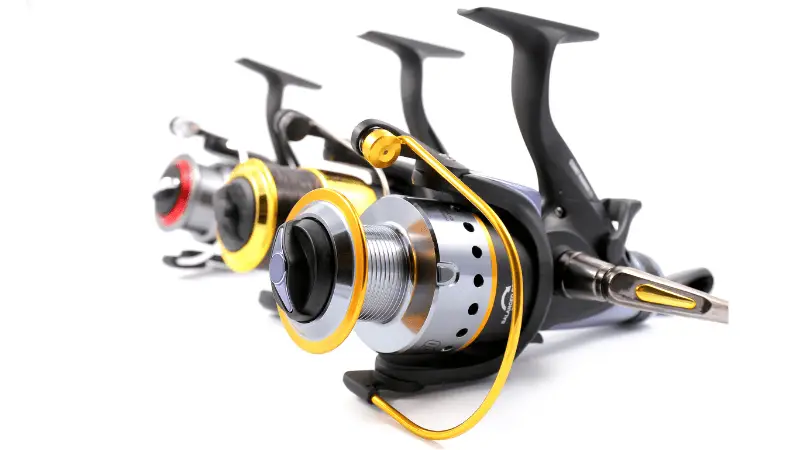
Welcome to the Spinning Reel Buyers Guide. Whether you’re casting off for the first time or looking to reel in a trophy catch, the right spinning reel can make all the difference.
Here we cover – what reel size to use, what type of fishing line to use, parts of a reel and more.
Let’s dive into what makes a spinning reel great and how to find the perfect one for you.
How Often Will The Fishing Reel Be Used?
When choosing a spinning reel, think about how much you’ll use it.
If you fish a lot, you want a quality reel that can keep up and won’t wear out. If you only fish occasionally, a budget reel might do.
You might be interested in these helpful articles – What Are The Types Of Fishing Reels?
Occasional Anglers vs. Daily Users
Occasional Anglers: If you only fish a few times a year, look for a reel that’s easy to use and doesn’t cost too much. These reels are good without worrying about the technical stuff.
Frequent Users: For those who fish often, investing in a higher-quality reel makes sense. These reels are built to last and handle lots of use. They have better quality parts, which means they work smoother and can handle bigger fish.
Where Will the Fishing Reel Be Used?
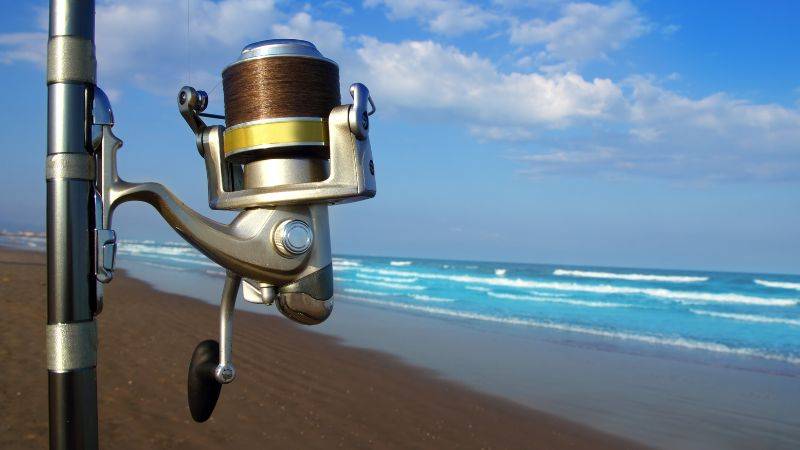
Freshwater vs. Saltwater Fishing
Where you plan to fish affects the type of reel you should get. Freshwater and saltwater have different challenges, and reels are designed to handle these environments.
Freshwater Fishing: Freshwater is easier on gear. You can use most reels without worrying too much about them rusting or breaking down.
Saltwater Fishing: Saltwater is tough on fishing gear. It can cause rust and damage parts. Look for reels made for saltwater. These have special materials and seals to protect them from the salt.
Environmental Impact: Choosing the right reel for your environment helps it last longer and reduces waste. Saltwater reels often use corrosion-resistant materials like aluminum or stainless steel.
Durability: Reels designed for saltwater are more durable because they have to be. This means they can be a bit more expensive, but they’re worth it if you’re fishing in the ocean.
Reel Sizes
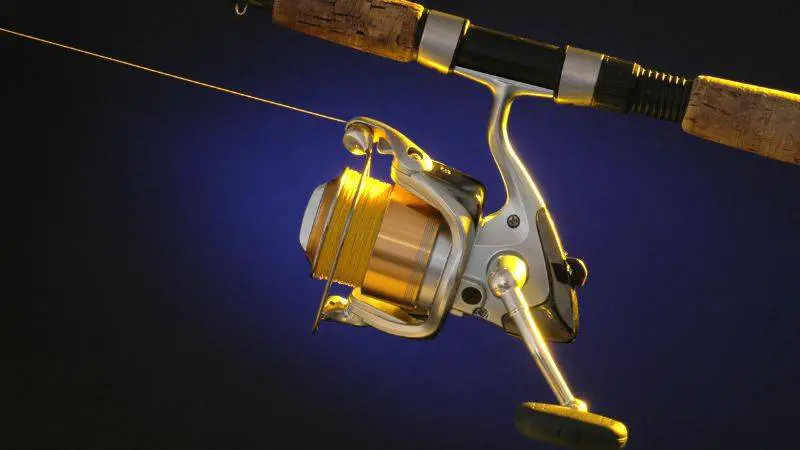
Reel size is super important. It’s like choosing the right size backpack – too big, and it’s awkward; too small, and your stuff doesn’t fit. The size of the reel should match the type of fishing you’re doing.
Small Reels (500, 1000 to 3000):
500 to 1000 size reels are good for light fishing. Like catching small pan fish or small trout in ponds, small rivers or lakes. This range is particularly accommodating for younger anglers as well.
Reels within this size bracket are ideal for their lightness and how well they match smaller, lighter rods. They are a great fit for the youngest fishing enthusiasts in your family.
2000-3000 size spinning reels are the go-to choice for a broad spectrum of fishing activities and targeting various species globally. Reels this size offer enough line capacity for casting distances ranging from moderate too long. They are versatile enough to handle a diverse array of fish.
A 2500 size spinning reel is very versatile for medium size freshwater fish like trout.
Medium Reels (3500 to 5000): These are versatile. They’re good for a bit of everything, from big river fishing to light ocean fishing.
3500 to 5000 size spinning reel is advisable when targeting larger predatory fish such as northern pike, salmon, and certain types of big catfish.
These reels feature a larger, often deeper spool, allowing for a significant amount of thicker line. Their internal components are designed to endure the challenges posed by larger fish and long battles.
Large Reels (6000 and above): Made for big fish and deep-sea fishing. They can hold a lot of heavy line for catching big ones.
Guide on Matching Reel Size with Fishing Line Weight and Target Species
Matching Tips: Think about what fish you want to catch. If you’re after small fish, a smaller reel with lighter line works great. For bigger fish, you need a larger reel that can hold heavier line.
Species-Specific: Some reels are better for certain types of fish because of how they’re built. For example, if you’re fishing for bass, a medium reel with a good drag system is perfect.
Tip: Always check the line weight your reel can handle. This info is usually on the reel. Matching your line weight to the reel helps you catch more fish and have more fun.
What Are the Parts of a Spinning Reel?
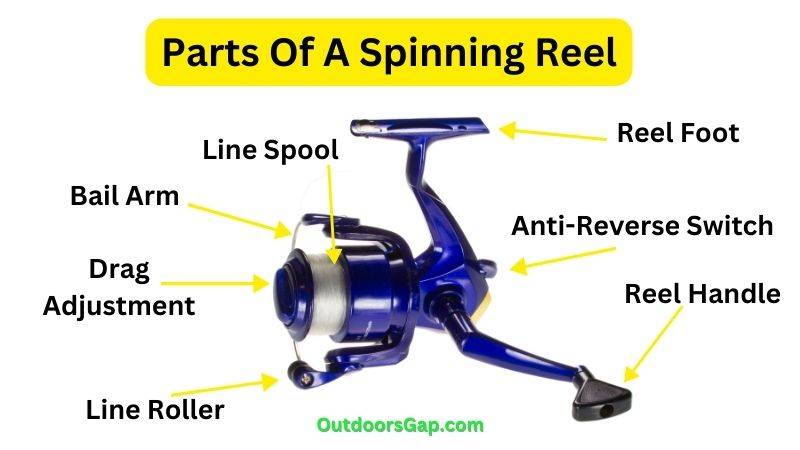
Each part of the spinning reel has a special role in helping you catch fish.
The spool needs to be big enough for your line. The handle should feel good in your hand, and the drag system has to work smoothly to fight big fish. The bail arm needs to move easily for casting.
All these parts working together make fishing easier.
Parts of a Spinning Reel
- Reel Body: The frame, consisting of the gear box housing and support arm, serves as the central structure for all other components.
- Reel Handle: Essential for performance, a smooth, easily operated handle can help your fishing success. Handles can typically be adjusted for right or left-hand use without tools.
- Reel Foot: Connects the reel to the rod, ensuring a secure fit and enhancing lure control.
- Bail Arm: Manages line on the spool, preventing unwinding when engaged. To cast, you must click over the bail arm.
- Spool: Stores your fishing line and works with the bail arm to secure the line properly.
- Anti-Reverse: A feature on premium reels that prevents the handle from spinning backward, allowing for more powerful hook sets.
- Line Roller: Facilitates line retrieval, guiding it onto the spool while preventing twists. Regular inspection is recommended to avoid damage to the line.
- Drag Knob: Adjusts spool pressure, crucial for managing fish fights. It allows for tighter control or lets larger fish run with the line to avoid breakage.
What Are Bearings Used For?
Role of Bearings in Reel Operation and Smoothness
Bearings in a spinning reel make it smooth to use. Bearings let the reel handle and spool turn easily, which is really important when you’re trying to reel in a big fish.
Importance of Bearing Quality and Quantity
Having good bearings in your reel makes a big difference. More bearings usually mean a smoother reel, but the quality of those bearings is super important too.
A budget fishing reel might only have 1 or 2 bearings. A higher quality fishing reel might have 6 or more bearings.
High-quality bearings work better and last longer, especially if you’re fishing in places where your reel might get wet or dirty.
If you are fishing occasionally, then a lower bearing reel would be fine. However, if you are fishing frequently and for long periods of time, a high quality reel and more bearings will help.
What Does Gear Ratio Mean?
Explanation of Gear Ratio and Its Impact on Retrieval Speed
The gear ratio of a spinning reel tells you how many times the spool turns around with one turn of the handle. If a reel has a gear ratio of 5.0:1, which means the spool spins around 5 times every time you turn the handle once.
A higher gear ratio means you can reel in your line faster.
Different types of fishing need different gear ratios. If you’re fishing in a way where you need to bring your lure in quickly, like when you’re using topwater lures, a higher gear ratio is great.
But if you’re fishing in deep water or need to pull in big fish, a lower gear ratio gives you more power. It’s like choosing between running fast or pulling a heavy load – you need the right gear for the job.
Fishing Reel Materials and Construction
Spinning reels are made from a variety of materials, each offering its own set of benefits:
- Aluminum: Strong and durable, aluminum is great for reels that need to withstand big fights with fish. It’s a bit heavier but very reliable.
- Carbon: Carbon reels are lighter, making them easier to handle, especially if you’re fishing for a long time. They’re strong too but can be more expensive.
- Magnesium: Magnesium is super lightweight and strong, perfect for freshwater fishing. However, it’s not the best choice for saltwater because it can corrode more.
Construction Features That Enhance Durability and Performance
For saltwater fishing, look for reels with sealed bearings and waterproof drag systems. These features help keep out water and dirt, making your reel last longer and perform better.
A solid construction also means the reel can handle bigger fish and tougher conditions.
Tip: A well-built reel with a strong frame and good materials can make a big difference in your fishing enjoyment.
Price: Finding a Balance between Quality and Affordability on Reels
When you’re looking for a new spinning reel, think about how much money you want to spend. There are spinning reels at all different prices, so you can find one that fits what you need and how much you can spend.
Tip: Set a budget before you start shopping. This helps you not spend too much but still get a great reel.
What Affects Their Cost
Spinning reels can range from very affordable to quite expensive. The cost is usually affected by the materials used, the construction quality, and the features it has.
Higher-priced reels often offer better durability, smoother operation, and more advanced features.
Higher-Quality Reels
Spending a bit more on a spinning reel can be a good idea. A better reel can handle bigger fish, won’t break as easily. It can make fishing more fun because it works smoother. Think of it as an investment in all the awesome fishing trips you’ll have in the future.
Tips for Getting the Best Value for Your Money
To get the most bang for your buck, consider what features you need. A mid-priced reel with good reviews and the right features can be a great choice. Also, look for sales or discounts on higher-end models.
The Okuma Cymar is a great example of one of the best spinning reels for its price level.
Fishing combos are another great way of getting value. Like the Daiwa combo. For more information, click on – Daiwa Rod Reel Combo RX Field Test
What Is the Best Fishing Line for Spinning Reels?
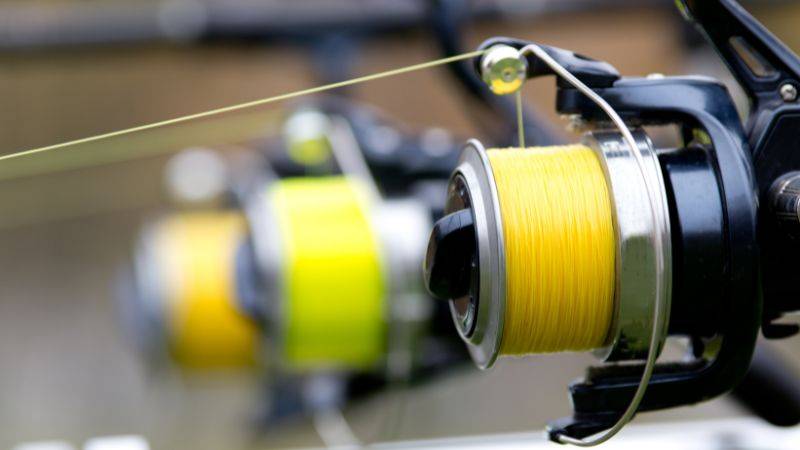
The best fishing line for spinning reels depends on the fishing situation, target species, and personal preference.
The three most common types of lines are monofilament (mono), braided (braid), and fluorocarbon lines.
Each has its own set of advantages and disadvantages.
Monofilament:
- Positives:
- Affordable and widely available.
- Has stretch, which can be forgiving during hooksets and fights with fish.
- Slowly sinks compare to fluorocarbon. Making it good for topwater lures and presentations.
- Negatives:
- Larger diameter than braid of the same strength, which can reduce casting distance and spool capacity.
- Susceptible to UV damage and has memory, leading to potential line twists and kinks.
Braided:
- Positives:
- High strength-to-diameter ratio, allowing more line on the spool.
- No stretch, offering excellent sensitivity and solid hooksets.
- Very durable with a long lifespan.
- Floats.
- Negatives:
- More visible under water, which can deter fish.
- Can be more difficult to tie knots due to its slippery nature.
- Tangles easy.
- Higher cost compared to monofilament.
- Need to use a mono of fluro leader with it.
Fluorocarbon:
- Positives:
- Nearly invisible underwater, making it great for clear water and wary fish.
- Great for leaders.
- Sinks, which is beneficial for fishing lures and baits deeper.
- Good abrasion resistance and less stretch than monofilament.
- Negatives:
- Stiffer, which can make spooling and casting more challenging.
- Generally more expensive than monofilament.
- Can be prone to memory, leading to potential line management issues.
Each type of line serves different fishing needs. The choice often comes down to the specific conditions and techniques used.
Maintenance Tips for Spinning Reels
Regularly clean your reel. Apply oil and grease to the moving parts as recommended by the manufacturer to keep everything running smoothly.
Tip: If fishing in saltwater, rinse your reel with fresh water after use. Then air dry it. This keeps it from corroding from the salt.
Top Spinning Reel Recommendations
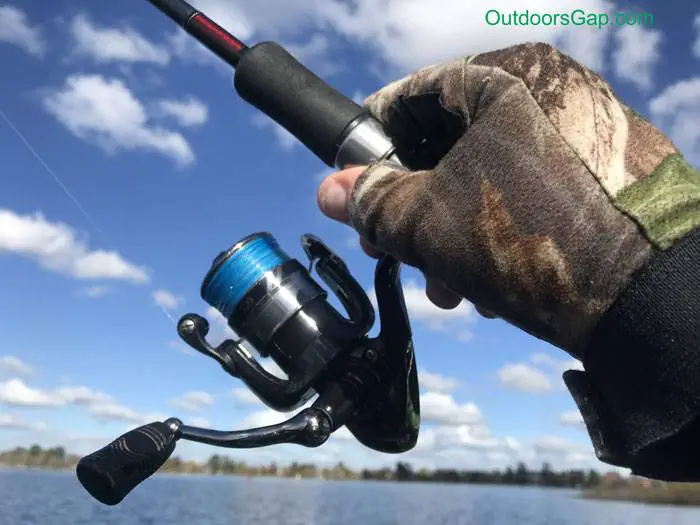
- Entry-Level: Shimano Sienna FG – Great for beginners, offering good quality at an affordable price.
- Mid-Range: Daiwa BG – A solid choice for regular anglers, with excellent durability and performance.
- High-End: Shimano Stella – Top of the line, with unmatched smoothness and strength for serious anglers.
Each of these reels caters to different types of anglers. From those starting out to experienced fishermen looking for the best equipment.
Frequently Asked Question (FAQs) About Spinning Reels
Can I use the same spinning reel for both freshwater and saltwater fishing?
Yes, you can use the same reel for both environments, but it’s crucial to choose a reel designed for saltwater if you plan to fish in the ocean frequently.
Saltwater reels have corrosion-resistant materials and protective coatings. Always rinse your reel with fresh water after saltwater use to prevent corrosion.
What does the term ‘drag system’ refer to on a spinning reel?
The drag system on a spinning reel allows you to set the resistance a fish feels when it pulls on the line.
A good drag system offers smooth resistance to a pulling fish, helping to tire it out without breaking the line.
Why is the gear ratio important in a spinning reel?
The gear ratio determines how many times the spool turns for one complete turn of the handle. A higher gear ratio means faster retrieval, which is beneficial for fishing techniques that require quick line retrieval.
Is Okuma a good brand?
Yes, Okuma is considered a reputable brand in the fishing industry. Known for producing a wide range of fishing gear that balances quality, innovation, and value.
Okuma cater to both novice and experienced anglers with products designed for various fishing conditions.
Is Daiwa better than Shimano?
Choosing between Daiwa and Shimano often boils down to personal preference, as both brands are renowned for their quality, innovation, and reliability.
Each offers unique features and technologies, making them favorites among different segments of anglers.
What is the difference between a 1000 and 2000 spinning reel?
The main difference lies in size and line capacity.
A 1000 reel is smaller and designed for lighter fishing, ideal for small fish and finesse techniques. A 2000 reel is slightly larger, offering more line capacity and strength, suitable for a broader range of fishing situations and slightly larger fish.
What is a 3500 size reel good for?
A 3500 size reel is versatile, ideal for targeting larger freshwater species like bass and walleye, and can also handle inshore saltwater fishing. It offers a good balance of line capacity and power for anglers looking to step up from smaller models without the bulk of larger offshore reels.
What is a 3000 size reel good for?
A 3000 size reel is great for anglers seeking versatility for both freshwater and light inshore saltwater fishing. It’s suitable for medium-sized species, providing a solid balance of line capacity and power in a relatively lightweight package.
How do I know what size reel to buy?
Reel size should be based on the type of fishing you plan to do and the size of the fish you’re targeting. Smaller reels (1000-2500) are good for light tackle fishing.
Medium reels (2500-4000) are versatile for general use, and larger reels (4000 and up) are better for bigger fish and heavier lines.
What’s the difference between a front drag and a rear drag spinning reel?
Front drag systems are located near the spool and generally offer a more consistent performance, especially for fighting big fish.
Rear drag systems, located at the back of the reel, are easier to adjust during a fight but might not provide as much durability or power as front drag systems.
How much fishing line should I put on my spinning reel?
Fill the spool to approximately 2mm (around 1/8 inch) from the rim.
Overfilling can cause tangles and knots, while under filling reduces casting distance and overall performance.
Can I switch the handle of the spinning reel from one side to the other?
Yes, most spinning reels allow you to switch the handle from one side to the other, accommodating both right and left-handed anglers.
This is usually a simple process that can be done without tools.
You might be interested in these helpful articles.
How To Change A Fishing Reel Handle
What Hand Do You Hold A Fishing Rod In?
What maintenance does a spinning reel need?
Regular maintenance includes cleaning your reel with fresh water after use, especially in saltwater, applying oil to moving parts, and greasing the gear system as needed based on usage.
Why do some reels have more bearings?
More bearings can lead to smoother reel operation, including casting and retrieving. However, the quality of the bearings is often more important than the quantity. High-quality bearings provide smoother performance and are more durable.
Is it worth buying a waterproof spinning reel?
If you frequently fish in harsh conditions or saltwater, a waterproof or water-resistant reel can be a good investment, protecting the internal components from corrosion and extending the reel’s lifespan.
Conclusion
Choosing the right spinning reel is crucial for a successful and enjoyable fishing experience.
This Spinning Reel Buyer’s Guide aims to arm you with the knowledge to select a reel that fits your needs, preferences, and budget.
The best reel is one that feels right for you, offers the durability to withstand your fishing adventures, and aligns with your goals.
Whether you’re after the calm of freshwater lakes or the adventure of saltwater coasts, the perfect spinning reel is out there waiting for you.

